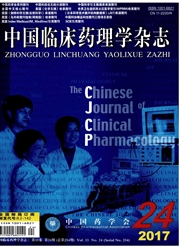

 中文摘要:
中文摘要:
目的探讨四个半LIM结构域蛋白1(FHL1)对肝癌细胞紫杉醇耐药的作用机制。方法按照FHL1的表达状态,设置敲低FHL1表达的肝癌细胞株为实验组,表达FHL1的肝癌细胞株为对照组,分别给予紫杉醇药物处理,并同时以奥沙利铂作为实验参照。细胞活性测定不同表达的细胞活性的改变,细胞克隆实验检测不同表达细胞的克隆形成。实验组和对照组的细胞克隆接种于裸鼠,并给予紫杉醇治疗,观察两组的成瘤情况以及对紫杉醇的反应。进一步的凋亡蛋白Caspase-3活性测定实验分别对两组Caspase-3活性进行测定。结果紫杉醇药物处理后,实验组和对照组的细胞活性分别为0.41±0.02和0.70±0.02(HepG2细胞);0.44±0.02和0.63±0.03(SMMC 7721细胞),差异均有统计学意义(均P〈0.05),且加入奥沙利铂后,实验组和对照组的细胞活性分别为0.70±0.02和0.71±0.02(HepG2细胞);0.64±0.02和0.63±0.03(SMMC 7721细胞),差异无统计学意义(P〉0.05)。实验组与对照组的克隆形成计数分别为93.52±14.58和302.48±21.56(HepG2细胞);55.14±10.82和192.28±19.47(SMMC 7721细胞),差异均有统计学意义(均P〈0.05);在裸鼠实验中,实验组与对照组肿瘤体积分别为0.02±0.02和1.89±0.51,差异统计学意义(P〈0.05)。此外,Caspase-3活性实验显示,实验组与对照组Caspase-3表达分别为10.27±0.47和26.72±0.54,差异有统计学意义(P〈0.05);加入抑制药Z-VAD-FMK后,实验组与对照组Caspase-3表达分别为8.87±0.36和29.96±0.68,差异有统计学意义(P〈0.05)。结论 FHL-1是紫杉醇耐药基因,FHL-1敲低后,紫杉醇的抗肿瘤作用增强,促进Caspase-3激活,紫杉醇诱导的细胞凋亡作用增强。
 英文摘要:
英文摘要:
Objective To investigate the mechanisms of four and a half LIM protein 1(FHL1) on paclitaxel resistance of hepatocellular carcinoma cells. Methods According to the expression of FHL1,two groups were set up: test group(hepatocellular carcinoma cell lines with knockdown of FHL-1) and control group(hepatocellular carcinoma cell lines expressing FHL-1). Both groups were treated with paclitaxel. In addition,oxaliplatin was used as a reference experiment. The antitumor effects of paclitaxel were detected by in vitro activity assay. The effects of paclitaxel on cell colony formation were analyzed by colony formation assay. The cell clones of both test group and contol group were inoculated in nude mice and then treated with paclitaxel. The situation of tumor growthand the effect of paclitaxel were observed. Meanwhile,the activity of Caspase-3 was determinated. Results The cell activity of the test group and the control group(HepG2 cells) was 0. 41 ± 0. 02 and 0. 70 ± 0. 02,respectively. The cell activity of the test group and the control group(SMMC 7721 cells) was 0. 44 ± 0. 02 and 0. 63 ± 0. 03,respectively.The difference was statistically significant. There was no significant difference in cell activity after the treatment of oxaliplatin(P〉0. 05). In cell colony formation,the numbers of clone formation were 93. 52 ± 14. 58 and 302. 48 ± 21. 56 in HepG2 cells. The numbers of clone formation were 55. 14 ± 10. 82 and 192. 28 ± 19. 47 in SMMC cells. The difference was statistically significant(P〈0. 05). There was no significant difference in cell activity after the treatment of oxaliplatin(P〉0. 05). In xenograft test,the tumor volume of the test group and the control group was 0. 02 ± 0. 02 and1. 89 ± 0. 51,respectively. The difference was statistically significant(P〈0. 05). Besides, the expression of Caspase-3 in the test group and the control group was 10. 27 ± 0. 47 and 26. 72 ± 0. 54,respectively. The difference was statistically significant(P〈0. 05). Aft
 同期刊论文项目
同期刊论文项目
 同项目期刊论文
同项目期刊论文
 期刊信息
期刊信息
